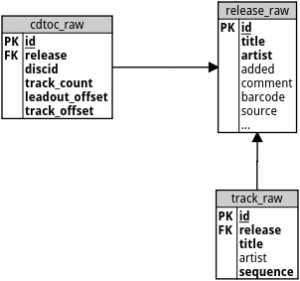User:Mineo/CDStubs: Difference between revisions
From MusicBrainz Wiki
Jump to navigationJump to search
No edit summary |
No edit summary |
||
| Line 3: | Line 3: | ||
The [[CDStub]]s table structure consists of only 3 tables: cdtoc_raw, release_raw and track_raw. |
The [[CDStub]]s table structure consists of only 3 tables: cdtoc_raw, release_raw and track_raw. |
||
The ''release_raw'' table contains basic metadata about the stub release, such as the artist and title |
The ''release_raw'' table contains basic metadata about the stub release, such as the artist and title. |
||
The individual tracks of each stub release are in the ''track_raw'' table, which holds the track title and its track number (in the ''sequence'' column). A tracks artist can be different than the artist of the release, so there's an ''artist'' column which can optionally contain the name of the tracks artist. |
|||
Each CDStub needs an associated [[Disc ID]], which is stored in the ''cdtoc_raw'' table, together with the track count of the disc, as well as the leadout and track offset ([[Disc_ID_Calculation#Audio_CD|Disc ID Calculation]] contains more information about the latter two). |
|||
Latest revision as of 13:03, 5 February 2015
CDStubs table structure
The CDStubs table structure consists of only 3 tables: cdtoc_raw, release_raw and track_raw. The release_raw table contains basic metadata about the stub release, such as the artist and title.
The individual tracks of each stub release are in the track_raw table, which holds the track title and its track number (in the sequence column). A tracks artist can be different than the artist of the release, so there's an artist column which can optionally contain the name of the tracks artist.
Each CDStub needs an associated Disc ID, which is stored in the cdtoc_raw table, together with the track count of the disc, as well as the leadout and track offset (Disc ID Calculation contains more information about the latter two).
